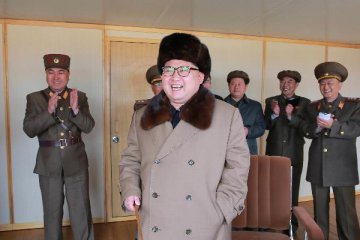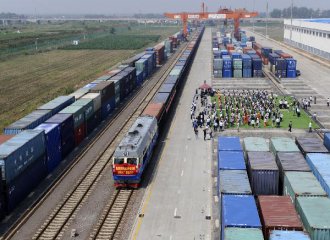International mineral prices have gone up by 14-50 percent, serving as a "lifesaver" for Peru's troubled economy, said economist Carlos Aquino, a professor at the National University of San Marcos in Peru's capital.
"In reality, Peru has met many problems, but we have luck because mineral prices are going up. Minerals account for around 60 percent of Peru's exports," Aquino told Xinhua.
During the first four months of the year, Peru witnessed a year-on-year rise in prices of copper, zinc, iron and tin by 14, 50.6, 43.3 and 16.8 percent, respectively.
Aquino said Peru's economy has been battered domestically for many reasons, including the revelation that Brazilian construction giant Odebrecht and top Peruvian officials embezzled millions of U.S. dollars in public funds, and extreme weather events such as the coastal El Nino phenomenon, causing devastating flash floods, even in parts of Lima.
However, increased commodity prices are helping raise Peru's growth forecasts.
"At the start of this year, the Peruvian economy was expected to grow between 3.7 and 3.9 percent. Now, everyone agrees, including the Central Reserve Bank (BCR), that we would grow 2.5 percent," said Aquino.
Considering Peru a big raw materials exporter, its gross domestic product (GDP) will see a reversal in its downward trend this year and further improvement in 2018.
"We don't control the prices of raw materials, which began to drop in 2011 and 2012. But now they are climbing and that is going to benefit us," said Aquino, noting copper, iron and gold are Peru's major exports.
In 2016, Peru was the world's second-largest copper producer after Chile, generating substantial revenues with an output of 2.3 million metric tons (MT).
According to the BCR, copper production is expected to total 2.5 million MT at the end of this year, and 2.7 million MT in 2018.
Copper is projected to trade at three U.S. dollars per pound (about 0.454 kg) at the end of the year, given large demand from China and the United States.
Copper exports in the first quarter of 2017 have brought in 3.978 billion dollars to Peru, with gold generating 2.323 billion dollars, the National Society of Mining, Petroleum and Energy (SNMPE) reported.
Mineral exports in the first quarter totalled 7.852 billion dollars, a year-on-year increase of 26.7 percent.
While Peru's commodity market has good prospects, public and private sector investments appear to be flagging, said Aquino.
"Public sector investment accounts for only 20 or 15 percent in total investment. The largest investor is the private sector, which isn't growing either. We need to ask 'why?'" he said.
The answer could lie in political instability, Aquino added.
"Why would people invest in a country? First, there is a chance for economic growth; second, the country can remain high in consumer confidence. Regrettably, in the past three years we have had problems," said the economist.
Aquino recalled that President Pedro Kuczynski, who came to power a year ago, has already been forced to dismiss three cabinet members.
He said it is hoped that Kuczynski's second year in office will see fewer clashes with opposition legislators and build consensus to shore up confidence in the economy.
"In reality, Peru has met many problems, but we have luck because mineral prices are going up. Minerals account for around 60 percent of Peru's exports," Aquino told Xinhua.
During the first four months of the year, Peru witnessed a year-on-year rise in prices of copper, zinc, iron and tin by 14, 50.6, 43.3 and 16.8 percent, respectively.
Aquino said Peru's economy has been battered domestically for many reasons, including the revelation that Brazilian construction giant Odebrecht and top Peruvian officials embezzled millions of U.S. dollars in public funds, and extreme weather events such as the coastal El Nino phenomenon, causing devastating flash floods, even in parts of Lima.
However, increased commodity prices are helping raise Peru's growth forecasts.
"At the start of this year, the Peruvian economy was expected to grow between 3.7 and 3.9 percent. Now, everyone agrees, including the Central Reserve Bank (BCR), that we would grow 2.5 percent," said Aquino.
Considering Peru a big raw materials exporter, its gross domestic product (GDP) will see a reversal in its downward trend this year and further improvement in 2018.
"We don't control the prices of raw materials, which began to drop in 2011 and 2012. But now they are climbing and that is going to benefit us," said Aquino, noting copper, iron and gold are Peru's major exports.
In 2016, Peru was the world's second-largest copper producer after Chile, generating substantial revenues with an output of 2.3 million metric tons (MT).
According to the BCR, copper production is expected to total 2.5 million MT at the end of this year, and 2.7 million MT in 2018.
Copper is projected to trade at three U.S. dollars per pound (about 0.454 kg) at the end of the year, given large demand from China and the United States.
Copper exports in the first quarter of 2017 have brought in 3.978 billion dollars to Peru, with gold generating 2.323 billion dollars, the National Society of Mining, Petroleum and Energy (SNMPE) reported.
Mineral exports in the first quarter totalled 7.852 billion dollars, a year-on-year increase of 26.7 percent.
While Peru's commodity market has good prospects, public and private sector investments appear to be flagging, said Aquino.
"Public sector investment accounts for only 20 or 15 percent in total investment. The largest investor is the private sector, which isn't growing either. We need to ask 'why?'" he said.
The answer could lie in political instability, Aquino added.
"Why would people invest in a country? First, there is a chance for economic growth; second, the country can remain high in consumer confidence. Regrettably, in the past three years we have had problems," said the economist.
Aquino recalled that President Pedro Kuczynski, who came to power a year ago, has already been forced to dismiss three cabinet members.
He said it is hoped that Kuczynski's second year in office will see fewer clashes with opposition legislators and build consensus to shore up confidence in the economy.





















Latest comments